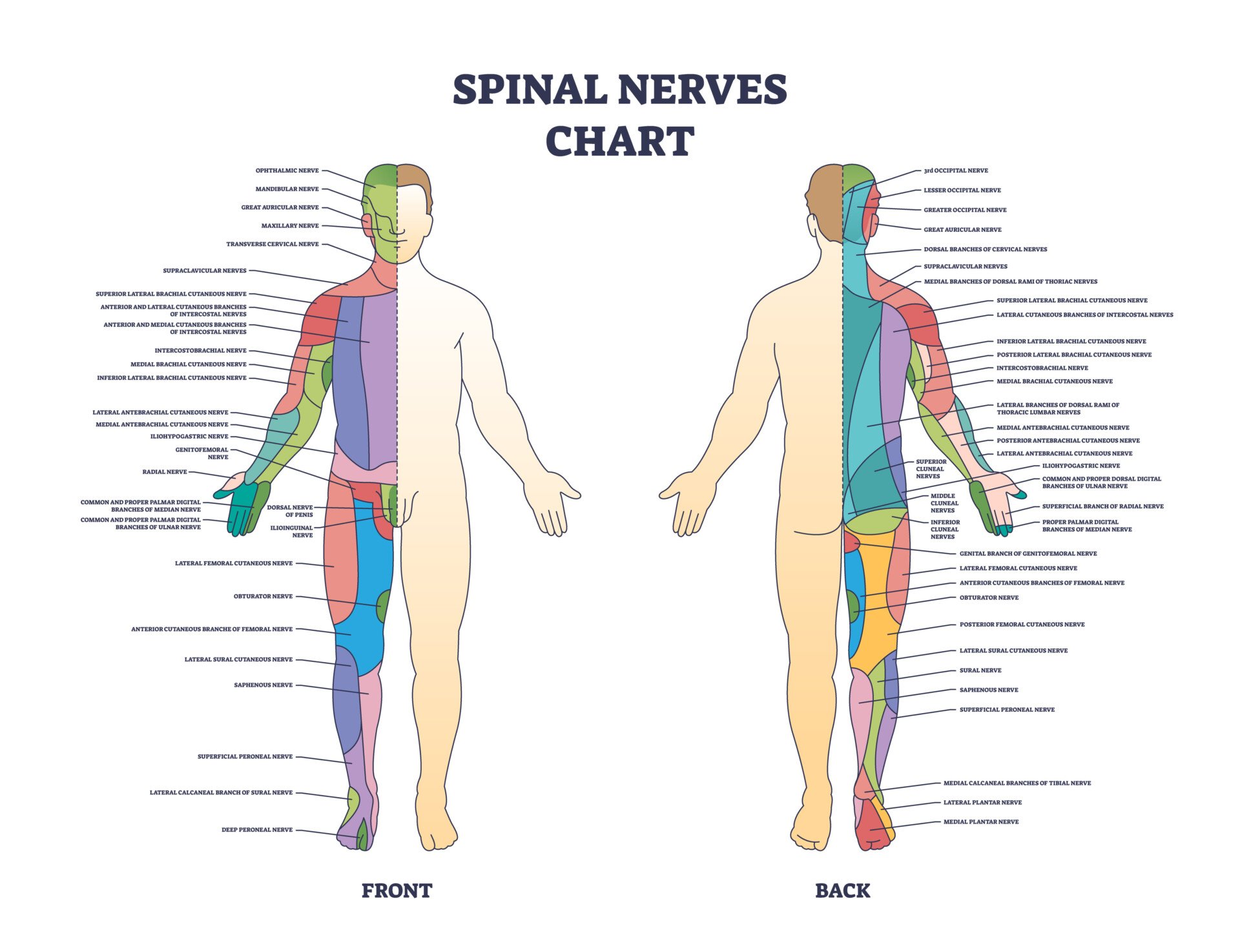On This Page:
The spinal nerves are the body’s major nerves within the peripheral nervous system (PNS). These nerves are integral to the PNS because they control motor, sensory, and autonomic functions between the spinal cord and the body.
There are 31 pairs of spinal nerves located at the cervical, thoracic, lumbar, sacral, and coccygeal levels:
8 pairs of cervical nerves (C1-C8).
12 pairs of thoracic nerves (T1-T12).
5 pairs of lumbar nerves (L1-L5).
5 pairs of sacral nerves (S1-S5).
1 pair of coccygeal nerves (CO1).
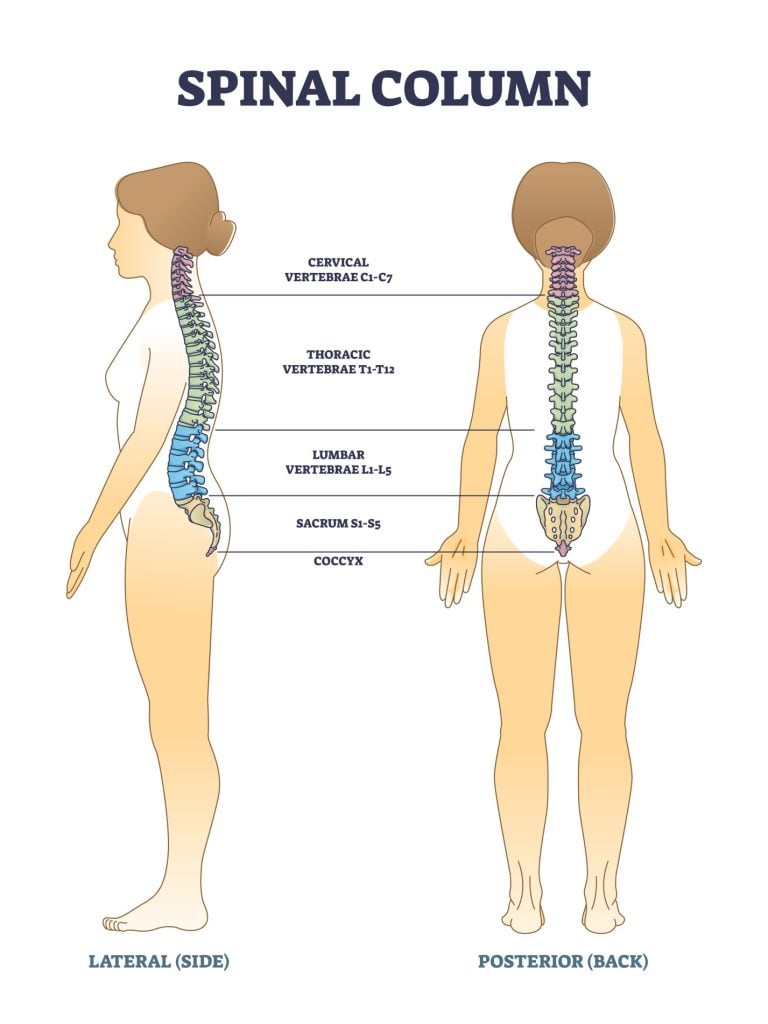
Each of these nerves branches out from the spinal cord, dividing and subdividing to form a network connecting the spinal cord to every part of the body.
Spinal nerves are structures that receive sensory information from receptors of the periphery body, and then transmit this information to the CNS.
Similarly, the spinal nerves transmit motor commands from the CNS to the muscles and glands of the periphery, so the brain’s instructions can be carried out quickly.
Anatomy of Spinal Nerves
Spinal nerves are large nerves that are distributed evenly along the spinal cord and the spine. The spine is a column of vertebrae bones that protects the spinal cord.
These spinal nerves are large as they are formed by both sensory and motor nerve roots merging together. These nerve roots emerge from the spinal cord, the sensory roots from the back of the spinal cord through the dorsal horns, whereas the motor roots emerge from the front through the ventral horns.
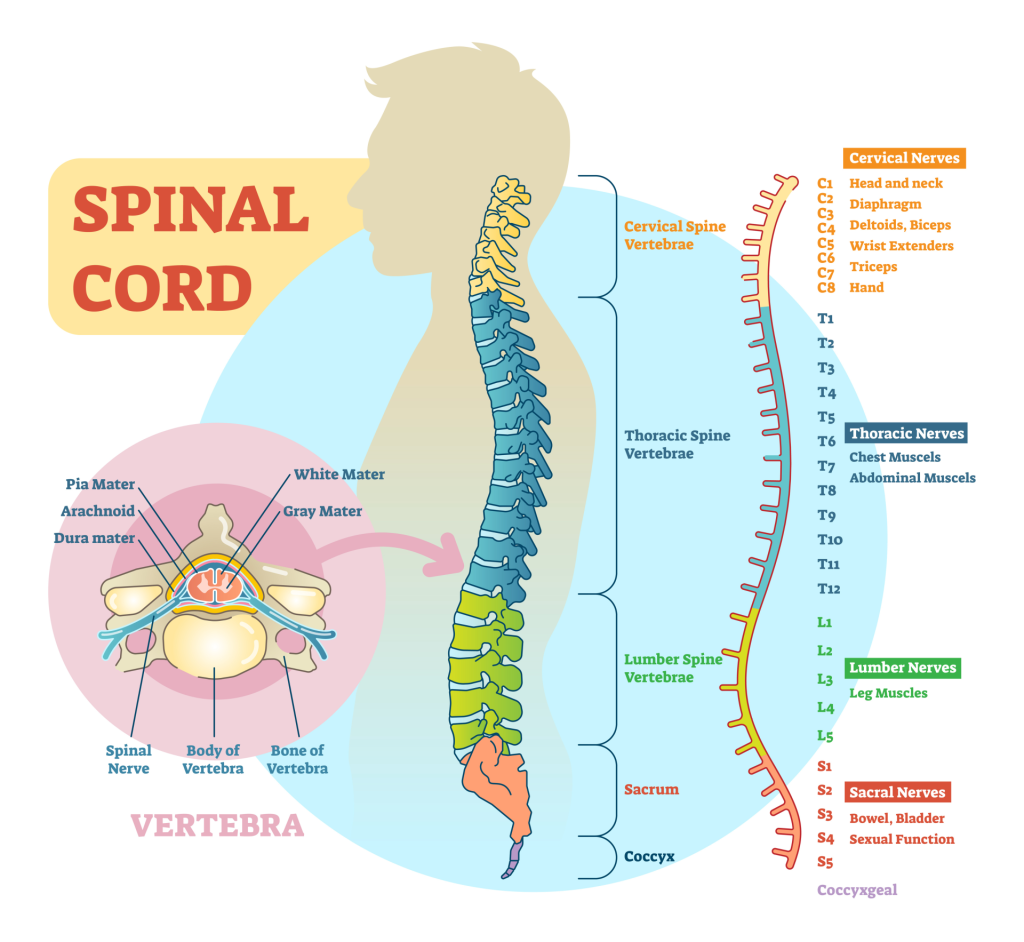
The spinal nerves are formed within a few centimeters of the spine on each side. Some groups of nerves merge to form a large plexus of nerves, whereas some divide into smaller branches without forming a plexus.
Spinal nerves emerge from the spinal column through an opening between adjacent vertebrae (known as intervertebral foramen).
This is the case for all spinal nerves except the first pair, which emerge between the occipital bone and the uppermost vertebrae.
Types and Spinal Nerves Function
As spinal nerves contain both sensory and motor fibers, they, therefore, have both sensory and motor functions. For sensory functions, the spinal nerves receive sensory messages from the skin, internal organs, and bones.
These spinal nerves will then send this sensory information to the sensory roots before reaching the sensory fibers at the back of the spinal cord.
For motor functions, the motor roots at the front of the spinal cord receive nerve messages and then transmit these messages to the spinal nerves.
Eventually, this information will be sent to small nerve branches, which will activate the muscles of the limbs and other body parts.
Cervical Nerves
There are 8 cervical nerves on each side of the spine (C1 to C8), located at the top of the spine, at the cervical vertebrae.
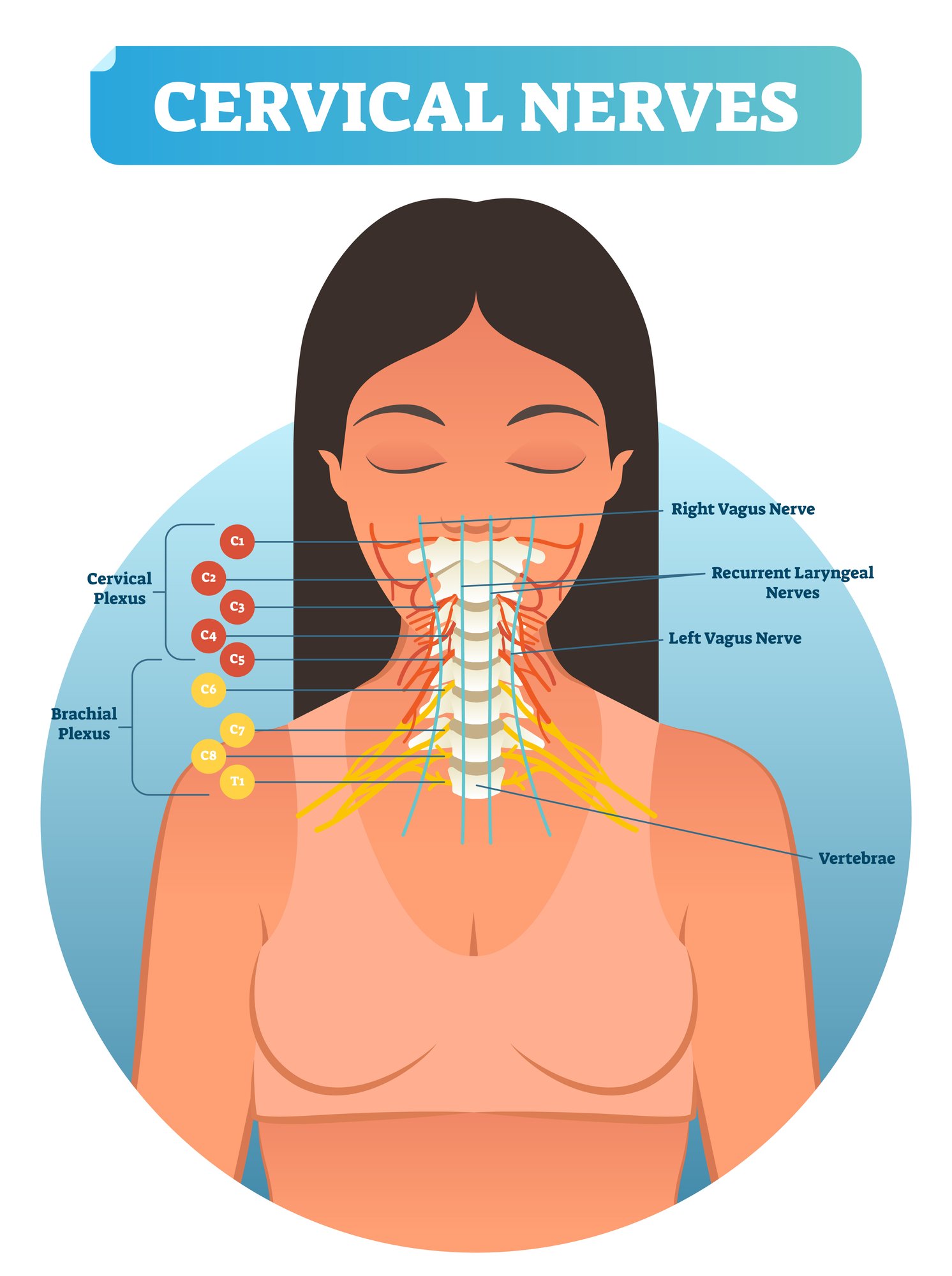
- C1, C2, and C3 cervical spinal nerves help to control the head and neck, including forward, backward, and sideward movements.
- C4 help to control the upper shoulder movements, as well as helping to power the diaphragm.
- C5 help to control the deltoids and biceps, the areas of the upper arm, down to the elbows.
- C6 help to control the wrist extensions, with some supply given to the biceps.
- C7 help to control the triceps as well as the wrist extensor muscles.
- C8 help to control the hands, as well as finger flexion (hand grip).
The cervical nerves C1 to C5 can form a cervical plexus through the merging of these nerves. These can divide into smaller nerves which can carry sensory messages and provide motor control to the muscles of the neck and shoulders.
Likewise, a brachial plexus can be formed by the combining of the nerves from C5 to thoracic nerve T1.
This plexus can branch into nerves that carry sensory messages to provide motor control to the muscles of the arms and upper back.
Thoracic Nerves
Next, below the cervical nerves, are 12 pairs of thoracic nerves on each side of the spine (T1 to T12), located at the thoracic vertebrae of the spine.
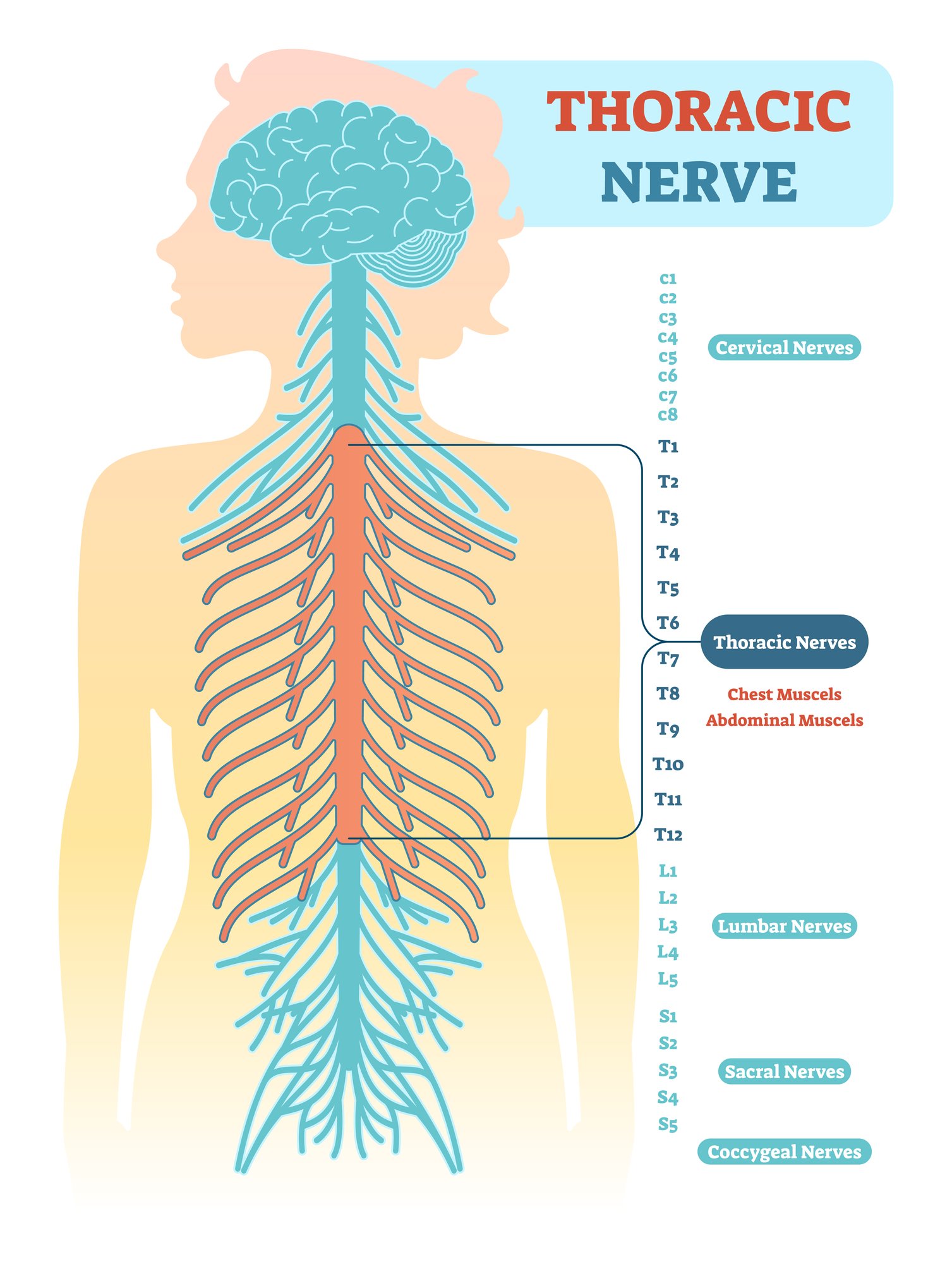
- T1 and T2 thoracic spinal nerves supply the top of the chest, arms, and hands.
- T3, T4, and T5 nerves supply into the chest wall as well as aid in breathing.
- T6, T7, and T8 nerves supply into the chest and down into the abdomen.
- T9, T10, T11, and T12 nerves supply into the abdomen and lower in the back.
Lumbar Nerves
Below the thoracic nerves are 5 pairs of lumbar nerves on each side of the spine (L1 to L5), located at the lumbar vertebrae of the spine.
- L1 lumbar spinal nerves provide sensations to the groin as well as the genitals.
- L2, L3, and L4 nerves provide sensations to the front of the thighs and the inner side of the lower legs. They also help to control movements of the hip and knee muscles.
- L5 nerves provide sensations to the outer side of the lower legs and the upper foot. These also help to control the hips, knees, feet, and toe movements.
The lumbar nerves L1 to L4 can combine to form the lumbar plexus, dividing into nerves that carry sensory messages and provide motor control to the muscles of the abdomen and legs.
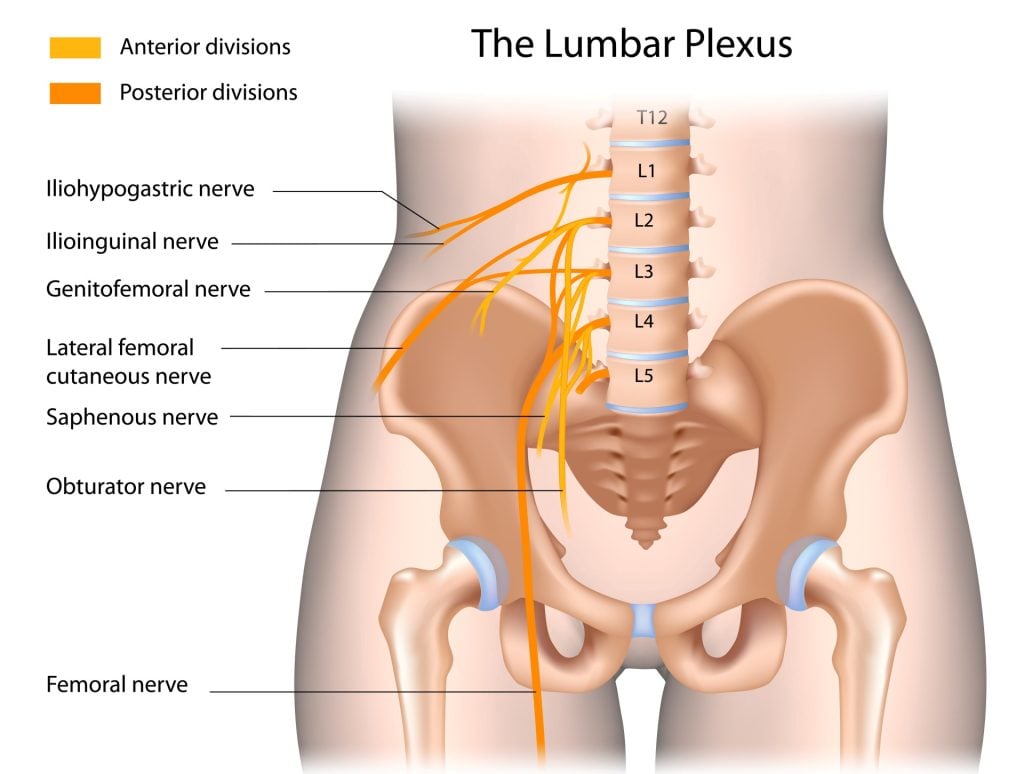
Sacral Nerves
Further down the spine are 5 pairs of sacral nerves on each side of the spine (S1 to S5), located at the sacrum.
- S1 sacral spinal nerves affect the hips and the groin area.
- S2 nerves affect the back of the thighs.
- S3 nerves affect the medial buttock area.
- S4 and S5 nerves affect the perineal area.
The spinal nerves from lumbar L4 to sacral nerves S4 can form the sacral plexus through the merging of these nerves. This plexus can divide into nerves that carry sensory messages and provide motor control to the muscles of the legs.
Coccygeal Nerves
Finally, at the base of the spine is 1 pair of coccygeal nerves on each side of the spine (CO1), located at the coccyx.
- CO1 spinal nerves innervate the skin around the coccygeal region, including around the tailbone.
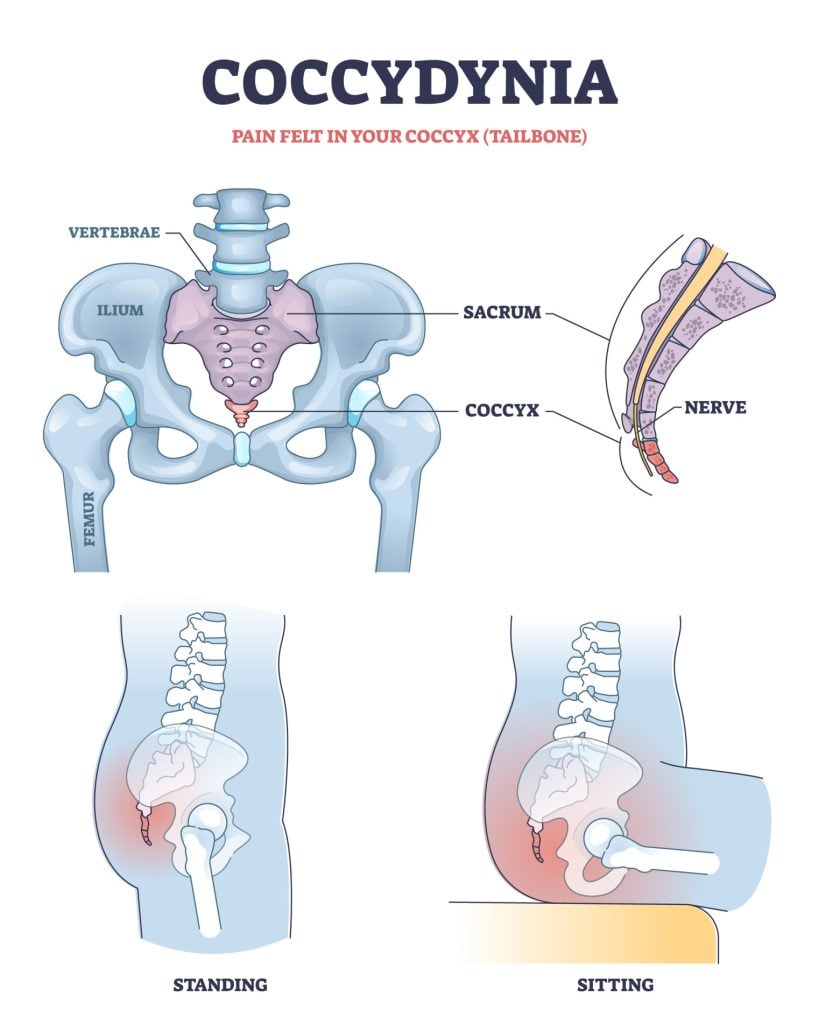
Spinal Nerve Damage
Below are some of the symptoms that can be experienced if damage were to occur to the spinal nerves:
- Pain – from mild to severe
- Changes in sensory sensations
- Weakness of muscles
- Diminished or weakened reflexes
- Feelings of numbness
- Lower back problems
- Tingling sensations in the limbs
Conditions that can affect the spinal nerves include the following:
Compressive neuropathy
This condition can occur when the spinal nerves are compressed. This can happen when the nerves that exit the spinal cord become trapped or swollen, and it can be extremely painful.
This condition typically affects older people, and the effects can be temporary or long-lasting, permanently destroying the spinal nerves.
Herniated disc
Also known as a slipped disc, this can occur when the vertebrae of the spine, including the cartilage, ligaments, and muscles, are disrupted. This disruption can cause the vertebrae to slip out of place.
A herniated disc can also cause nerve compression and usually causes neck pain as a first symptom, accompanied by sensations of tingling, numbness, and weakness in other parts of the body.
A Herniated disc can cause permanent damage to the spinal cord.
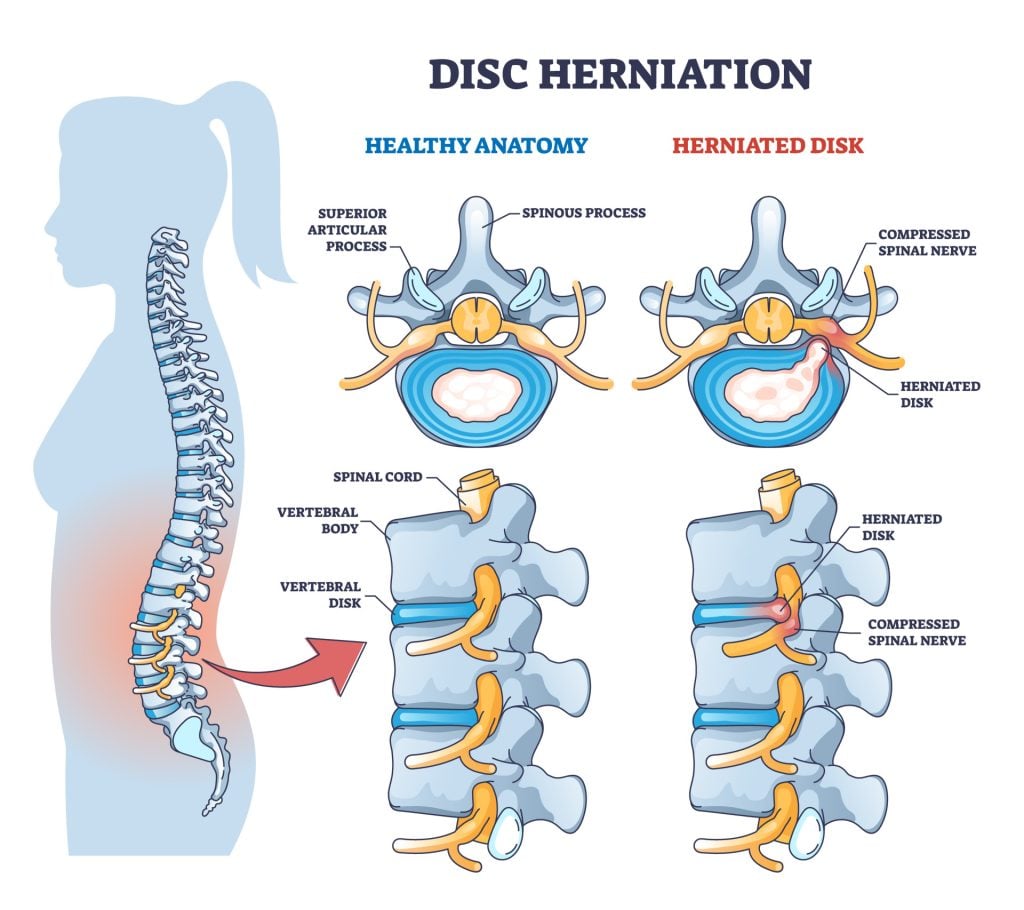
Trauma
Spinal nerves can become damaged either mildly or severely after traumatic accidents. Trauma to the neck can come as a result of falling or blunt force to the neck, for instance.
This trauma can result in swelling, stretching, or tears of the cervical spinal nerves or the cervical plexus.
Lifting heavy objects or blunt force to the lower back can result in the lumbar spinal nerves or lumbar plexus being damaged and lead to lower back pains.
Spinal infections
Types of spinal infections can include disc infections and spinal bone infections and typically cause inflammation and pain which may travel into other parts of the body.
A spinal infection may begin near spinal nerve roots and thus will take effect on the spinal nerves which branch from it.
Guillan Barre Syndrome (GBS)
This is a condition that attacks the myelin sheath (protective insulating layer) of the neurons.
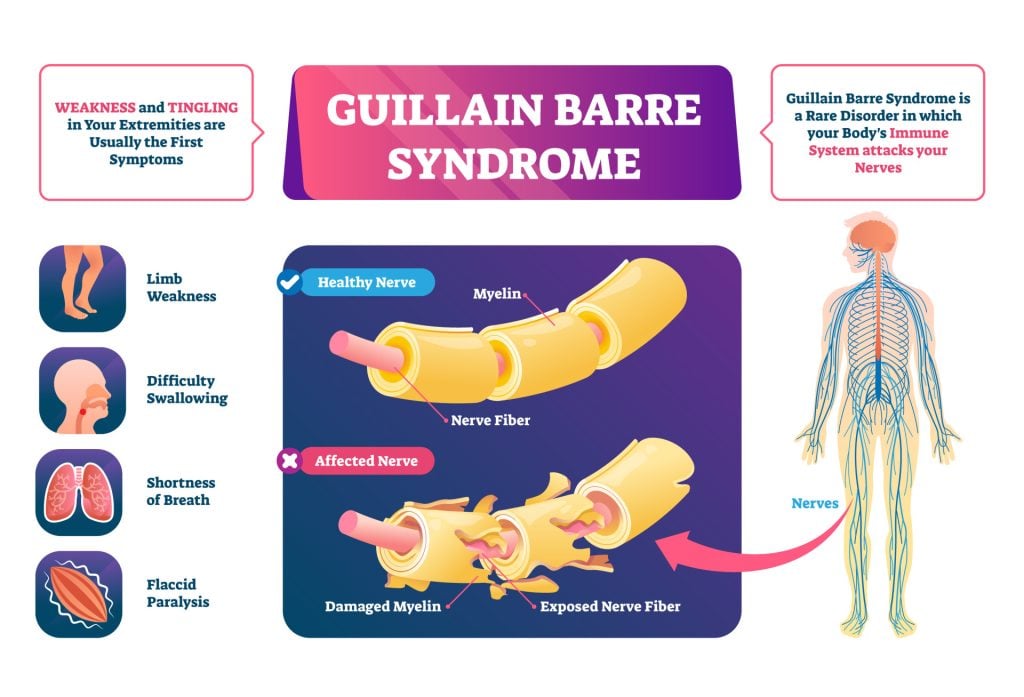
As this is a demyelinating condition, it can weaken the spinal nerves over time and cause weakness and tingling sensations all over the body. Eventually, it may even impair the muscles which control breathing.
Treatments of spinal nerve damage depend on the issue at hand. If there is an infection or inflammatory problem, anti-inflammatory medication can usually manage the milder symptoms.
Similarly, mild nerve pain may be managed with over-the-counter pain medication.
Otherwise, specific exercises and physical therapy may be recommended by a doctor to help alleviate the pressure caused by more severe spinal nerve damage and help reduce the overall pain.
References
Eidelson, S. G. (2019, June 3). Spinal Nerve Disorders. https://www.spineuniverse.com/conditions/sciatica/spinal-nerve-disorders
Moawad, H. (2020, January 18). The Anatomy of Spinal Nerves. Very Well Health. https://www.verywellhealth.com/spinal-nerves-anatomy-4682599#associated-conditions
Gorman, N. (2021, May 31). Spinal Nerves. Kenhub. https://www.kenhub.com/en/library/anatomy/spinal-nerves
Lumen. (n.d.). Spinal Nerves. Retrieved 2021, August 9 from: https://courses.lumenlearning.com/boundless-ap/chapter/spinal-nerves/
